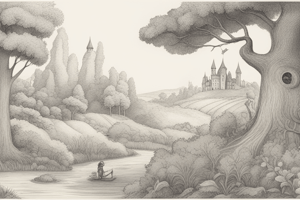Podcast
Questions and Answers
What is the primary function of the larynx?
What is the primary function of the larynx?
- To regulate body temperature
- To facilitate gas exchange
- To filter out dust and pollen
- To produce sound during speech (correct)
Which structure in the respiratory system is responsible for warming and humidifying inhaled air?
Which structure in the respiratory system is responsible for warming and humidifying inhaled air?
- Bronchi
- Pharynx (correct)
- Alveoli
- Trachea
What is the function of cilia in the trachea and bronchioles?
What is the function of cilia in the trachea and bronchioles?
- Producing sound
- Removing mucus and particles (correct)
- Facilitating gas exchange
- Regulating body temperature
Where does gas exchange occur in the respiratory system?
Where does gas exchange occur in the respiratory system?
Which structure connects the nasal cavity, mouth, and larynx?
Which structure connects the nasal cavity, mouth, and larynx?
What kind of structures are alveoli?
What kind of structures are alveoli?
What is the primary function of the respiratory system?
What is the primary function of the respiratory system?
Which gas is exchanged during the process of respiration?
Which gas is exchanged during the process of respiration?
How does the respiratory system help regulate blood pH balance?
How does the respiratory system help regulate blood pH balance?
Why is warm, moist air more favorable for breathing?
Why is warm, moist air more favorable for breathing?
Which of the following is NOT a function of the respiratory system?
Which of the following is NOT a function of the respiratory system?
What is a vital role of hemoglobin in the respiratory system?
What is a vital role of hemoglobin in the respiratory system?
Study Notes
The Respiratory System
The respiratory system is a complex and essential network of organs, tissues, and passageways that facilitate the process of breathing and the exchange of gases between our body and the environment. Its primary functions are to deliver oxygen to our cells and tissues, and to remove carbon dioxide, a waste product of cellular metabolism.
Functions of the Respiratory System
-
Gas exchange: The respiratory system facilitates the exchange of oxygen (O₂) and carbon dioxide (CO₂) between the air and our bloodstream. Oxygen enters our body through inhalation, where it is transported by hemoglobin in red blood cells to the cells throughout our body. Carbon dioxide, produced as a waste product of cellular respiration, is transported in our bloodstream back to the lungs, where it is expelled from our body during exhalation.
-
Maintaining pH balance: The respiratory system plays a crucial role in regulating the acid-base balance of the blood by removing CO₂, a product of cellular metabolism that can increase blood acidity (lower pH).
-
Temperature and humidity control: Our respiratory system helps regulate the temperature and humidity of the air that enters our lungs. Warm, moist air is more comfortable to breathe and facilitates the efficient exchange of gases.
Anatomy of the Respiratory System
The respiratory system is made up of several organs and structures that work together to carry out its functions:
-
Nose: Functions as a filter, warmer, and humidifier. The nasal cavity contains hair and mucus that trap dust, pollen, and bacteria, while the nasal cycle allows for warming and humidifying the inhaled air.
-
Pharynx: A common tube that connects the nasal cavity, mouth, and larynx. It performs the function of swallowing food and liquids, and during inhalation, the pharynx contracts and creates a passageway to the larynx and trachea.
-
Larynx: A hollow, cartilaginous structure that contains the vocal cords. Its primary function is to protect the airway and regulate the passage of air into and out of the lungs. The larynx also produces sound during speech.
-
Trachea: A tube-like structure that connects the larynx to the primary bronchi. The trachea is lined with cilia, which help remove mucus and trapped particles.
-
Bronchi: The primary bronchi divide into secondary and tertiary bronchi, which ultimately form the bronchioles. The walls of the bronchi and bronchioles are lined with cilia and mucus-producing cells, which help remove dust, debris, and bacteria from the air.
-
Alveoli: Small, grape-like structures at the end of the bronchioles where gas exchange occurs. Alveoli are surrounded by a network of capillaries, which facilitate the exchange of oxygen and carbon dioxide between the air and bloodstream.
In summary, the respiratory system is a vital organ system that performs essential functions such as gas exchange, pH regulation, and temperature and humidity control. Understanding its anatomical structures and functions allows us to appreciate the importance of maintaining healthy respiratory function.
Studying That Suits You
Use AI to generate personalized quizzes and flashcards to suit your learning preferences.
Description
Learn about the complex organ system responsible for breathing and gas exchange in the body. Explore the anatomy of the respiratory system, including organs like the nose, pharynx, larynx, trachea, bronchi, and alveoli, and understand its vital functions such as gas exchange, pH regulation, and temperature control.




